Appearance
Roof
Bottom Line
A roof in good condition, debris-free, not made of wood or plastic panels, and with no openings at the eave edge or ridges larger than 1/8 inch will reduce the risk posed by embers.
Overview
While noncombustible roof materials offer the best protection, a roof in good condition made of any material except wood or plastic panels is the first line of defense against ember and radiant heat exposures during a wildfire. Wood and plastic panel roofs, even those impregnated or treated with retardant chemicals to achieve a Class B fire rating, are vulnerable and should always be replaced.
Accumulated debris should always be cleared to reduce wildfire risk and prolong the life of the roof.
Barrel tile, corrugated metal, and some standing seam metal roofs can be vulnerable to ember ignition and must be mitigated.
Roof condition
Maintaining a roof in good condition is the most important thing you can do to prevent ignitions from wildfires. There should be no sags in the roof to catch debris and embers nor missing or exposed sections. In short, the roof’s integrity must be intact. The roof material section shows examples of roof condition by material.
Roof Material
When replacing a roof, it’s important to install a Class A fire-rated roof as defined by ASTM E108 (also known as UL 790). To achieve a Class A fire rating, a roof assembly must resist flame spread and flame penetration for a specified amount of time.
Many Class A fire-rated roofs meet the flame penetration requirement through a combination of roof material and underlayment. Practically, the underlayment should not be visible nor accessible after installation; if it is, the roof is likely improperly installed.
In California, most roofs installed since 2008 have a Class A fire rating.
Asphalt composite shingle
Asphalt fiberglass composition shingles currently comprise about 2/3rds of the market in California. Its fire rating comes from the fiberglass fibers in the asphaltic component and the granules on the top (exposed) surface.
It’s worth noting the asphalt composition roofing industry transitioned to fiberglass fibers (Class A fire rating) from cellulosic fibers (Class C fire rating) non-uniformly over all manufacturers between 2005 and 2010 (Source: Personal communication with the Asphalt Roofing Manufacturers Association).
Indications of an asphalt composition shingle roof covering that is in poor condition include missing granules and curled up shingles. A roof covering in poor condition should be replaced.
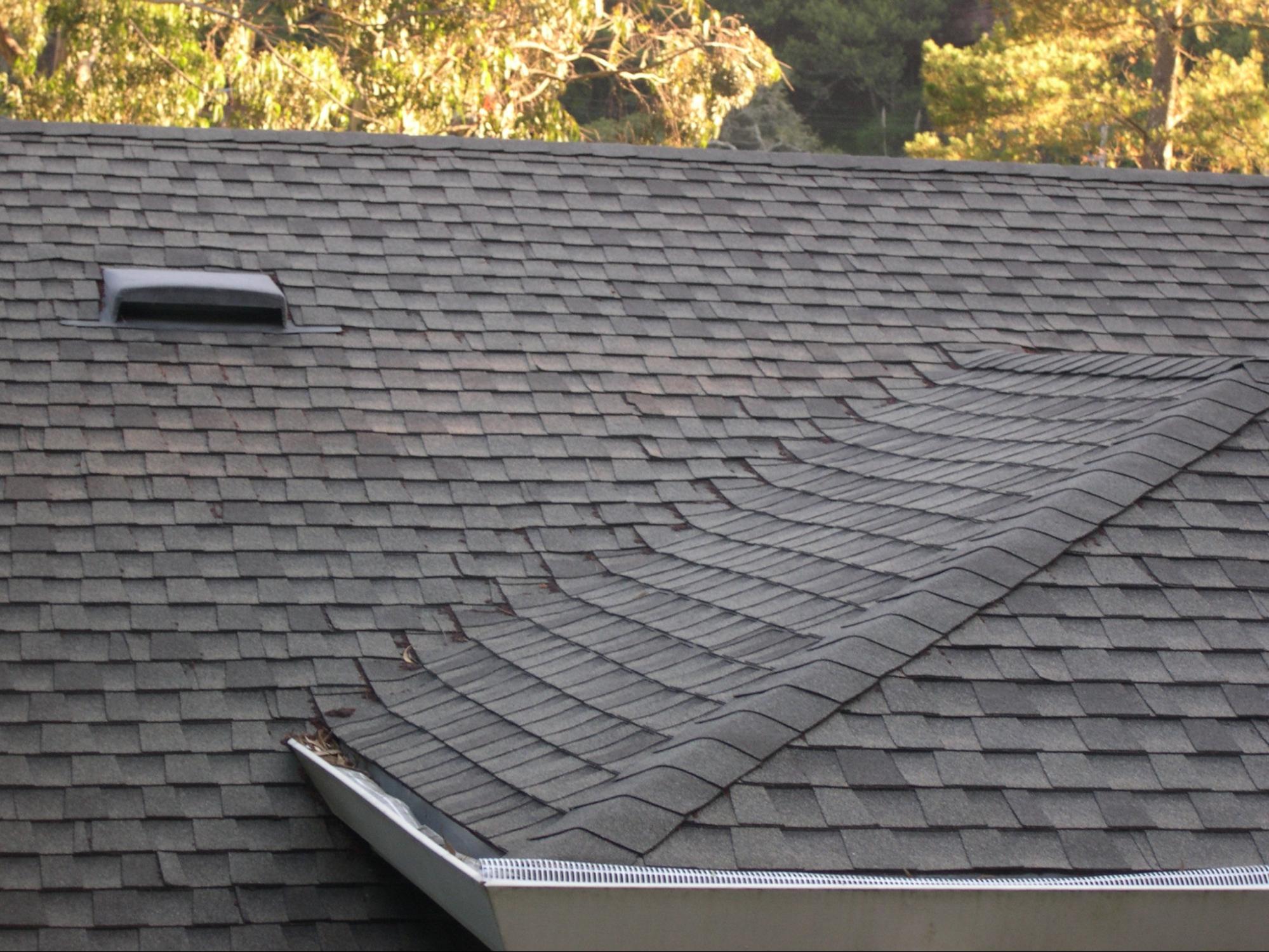 Asphalt composite roof in good condition.
Asphalt composite roof in good condition.
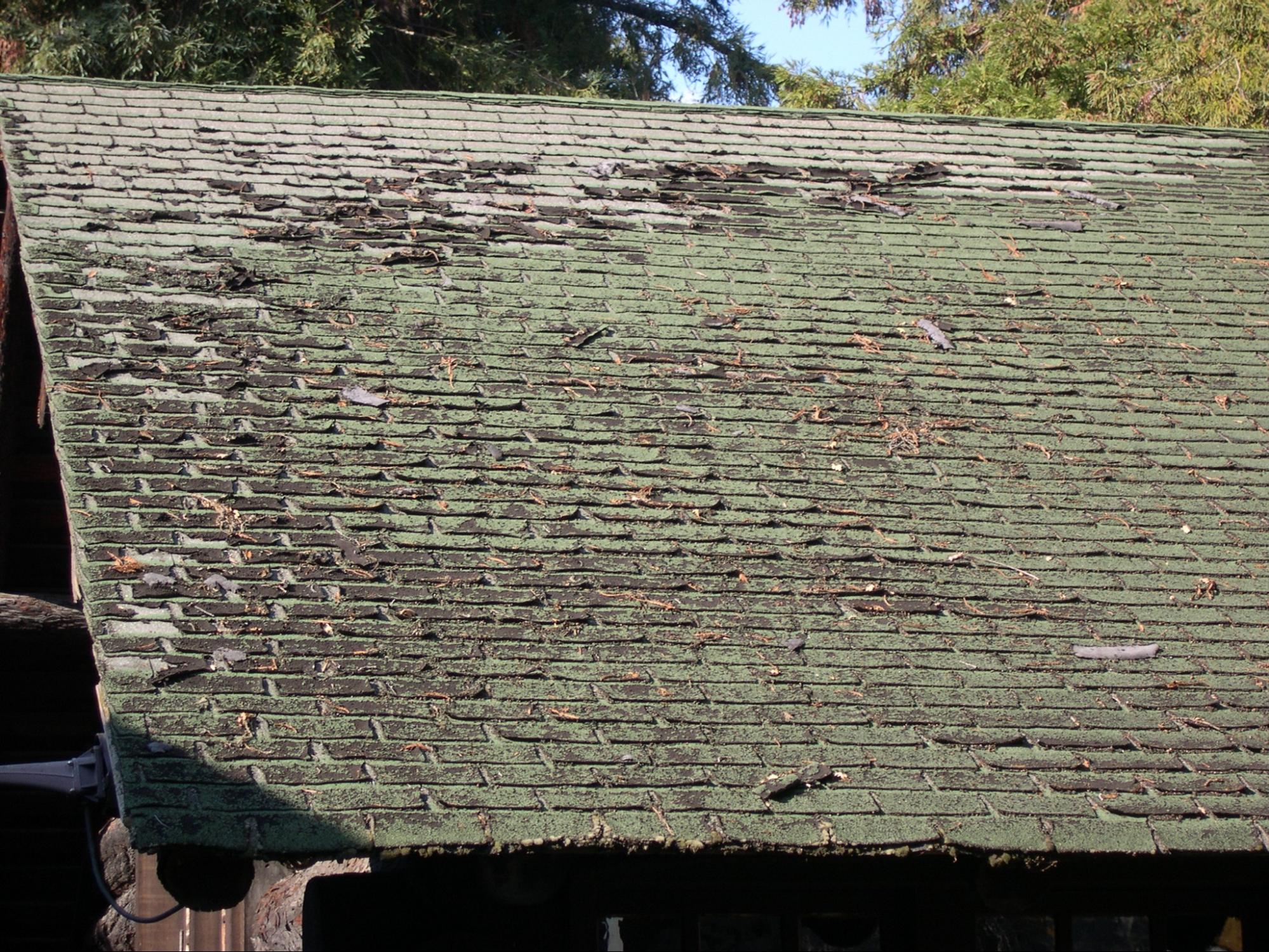 Asphalt composite roof with significant lifting, curling, and delamination compounded by moss and lichen accumulation. This roof’s condition is not good and should be replaced.
Asphalt composite roof with significant lifting, curling, and delamination compounded by moss and lichen accumulation. This roof’s condition is not good and should be replaced.
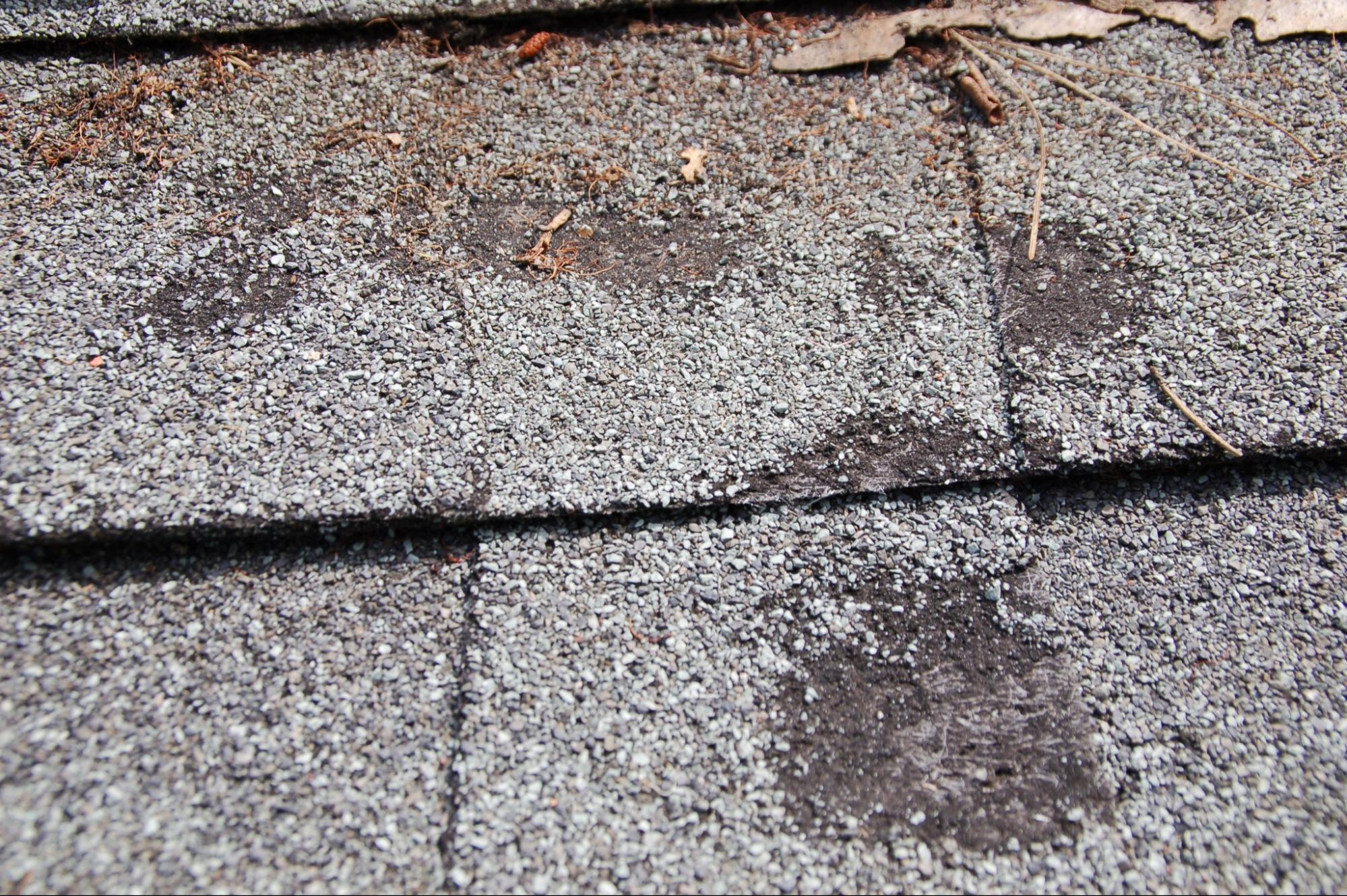 Asphalt composite roof close up with missing granules. This roof’s condition is not good and should be replaced.
Asphalt composite roof close up with missing granules. This roof’s condition is not good and should be replaced.
Wood
Wood shakes or shingles that are pressure-impregnated with a fire retardant chemical meet the requirement for a Class B fire rating. Treatments that are user-applied after installation cannot qualify as Class B. Even factory-treated roofing materials will degrade with exposure to the elements and lose their flame resistance within a relatively short amount of time compared to other roofing materials.
A wood roof should be replaced with a Class A fire-rated roof regardless of its condition.
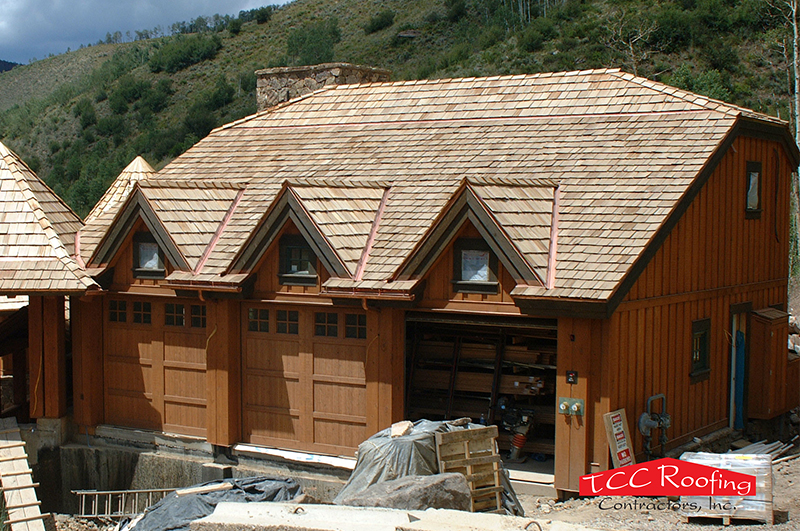 Wood roof covering that was likely pressure-impregnated with a fire retardant chemical that will decrease in effectiveness in a relatively short amount of time. All wood roofs should be replaced with a Class A fire-rated roof regardless of condition or age. Credit: TCC Roofing Contractors, Inc.
Wood roof covering that was likely pressure-impregnated with a fire retardant chemical that will decrease in effectiveness in a relatively short amount of time. All wood roofs should be replaced with a Class A fire-rated roof regardless of condition or age. Credit: TCC Roofing Contractors, Inc.
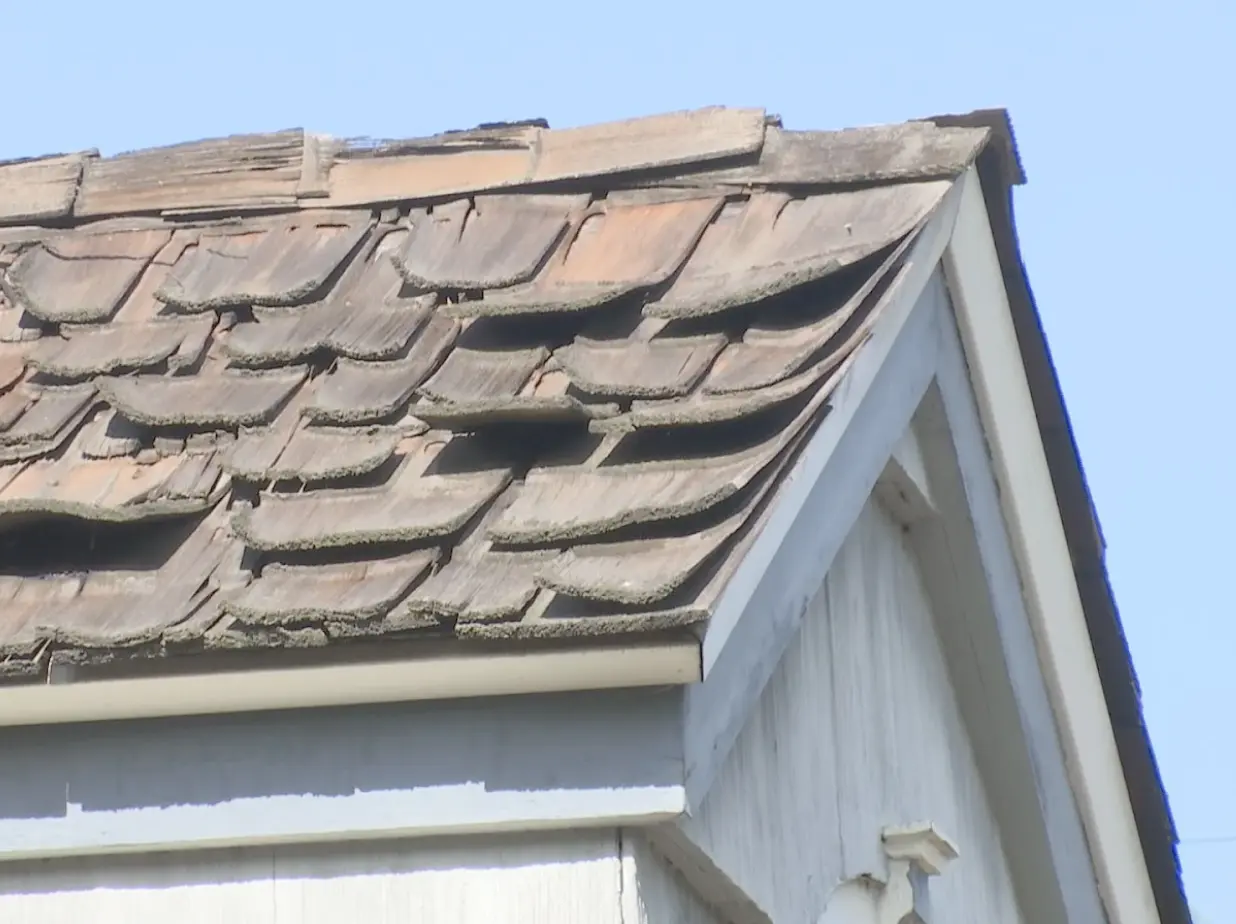 Wood shake roof covering in poor condition.
Wood shake roof covering in poor condition.
Metal
Metal roofing materials include steel, copper, or aluminum standing seam or corrugated metal.
Standing seam
Steel or copper standing seam metal roof coverings are durable and wildfire resistant. An example of an underlayment that improves the fire performance of the covering is GAF Versashield. When used in conjunction with the steel or copper roof covering, a Class A fire rating is assured. An additional underlayment would be needed for an aluminum covering to achieve a Class A fire rating. If you observe discoloration in the topside resin coat or rust due to corrosion of the underside coating, then the condition of the roof is no longer good and replacement should be planned.
Aluminum roofing materials can be detected by using a magnet. If the roof covering is metal but the magnet does not stick, then the roof is aluminum, which is not a magnetic metal. If the magnet sticks, then it is steel or copper.
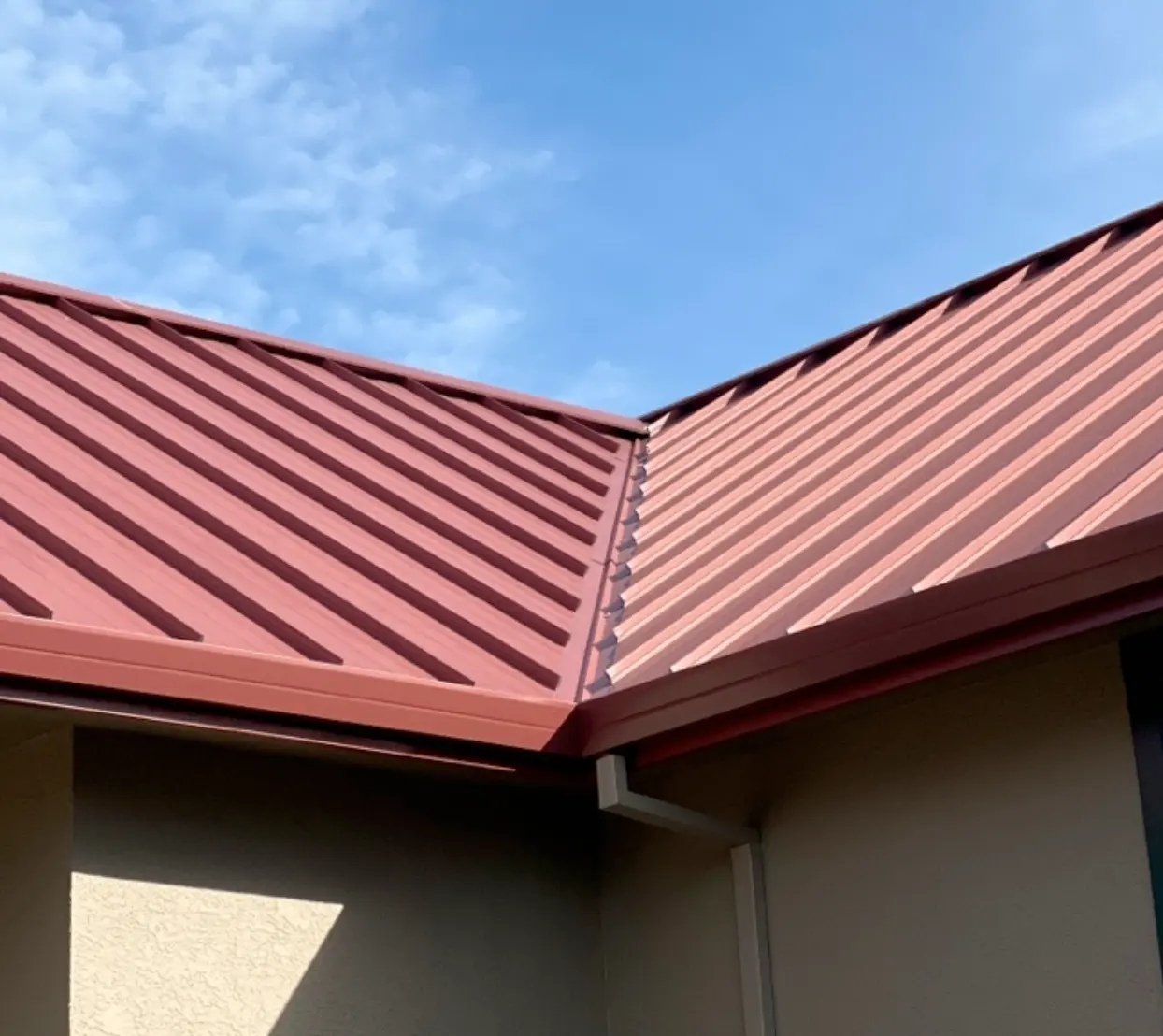 Standing seam steel roof covering in good condition.
Standing seam steel roof covering in good condition.
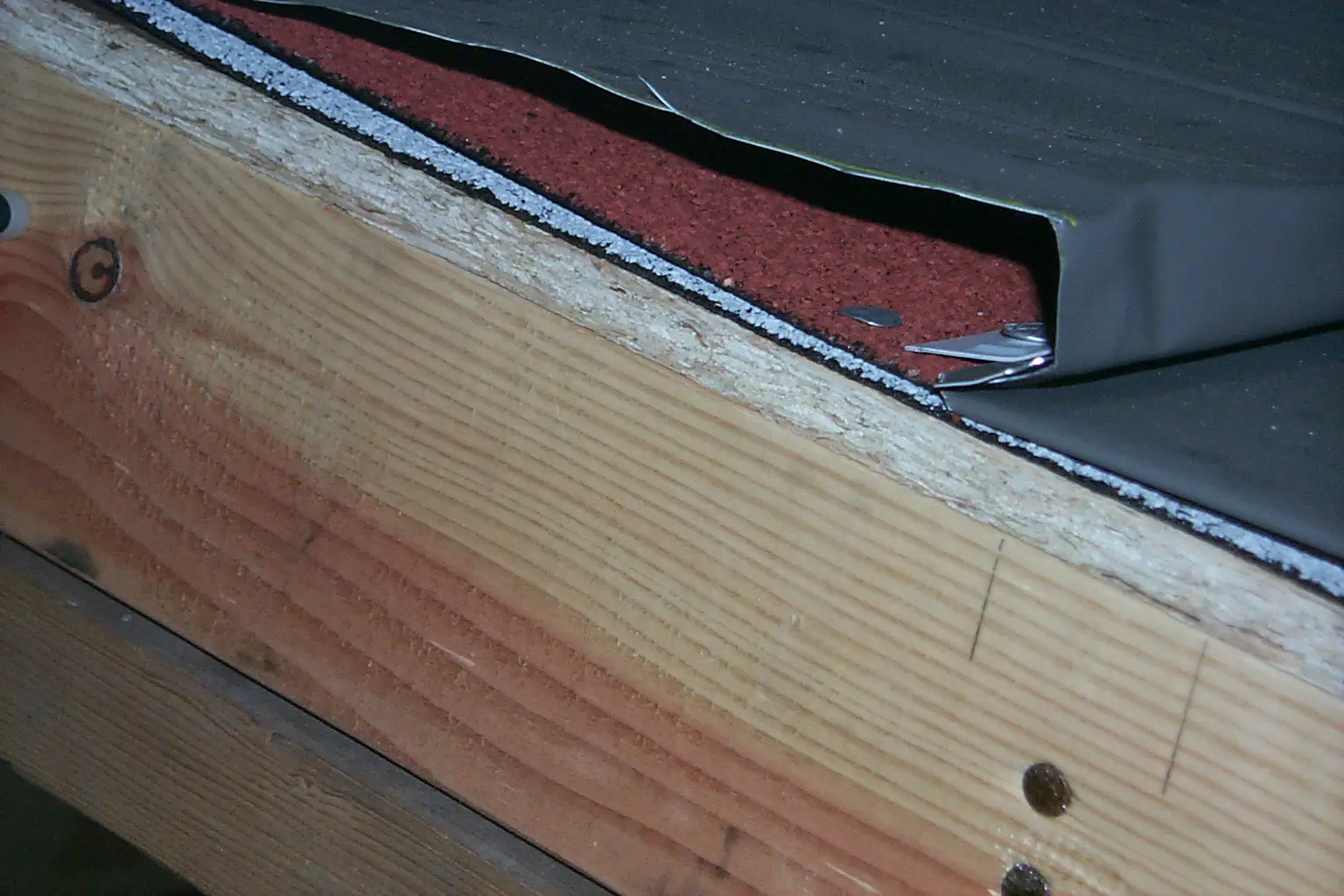 Aluminum roof covering with an asphalt fiberglass composition roll roofing product used as an underlayment. Note that this is a cutaway view of a specimen under evaluation in a laboratory environment.
Aluminum roof covering with an asphalt fiberglass composition roll roofing product used as an underlayment. Note that this is a cutaway view of a specimen under evaluation in a laboratory environment.
Corrugated metal
Typically made of hot dipped galvanized steel, this versatile material can be used for roofs, siding, or fences. It comes in a variety of shapes and finishes, but its defining characteristic is an undulating shape that provides its strength.\
Corrugated metal roofs with visible holes or advanced rust are not in good condition and should be replaced.\
As long as any raised ends are plugged to prevent intrusion of debris and embers (see open ends or ridges), and there are no gaps or dips in the roof panels, then corrugated metal can be wildfire resistant.
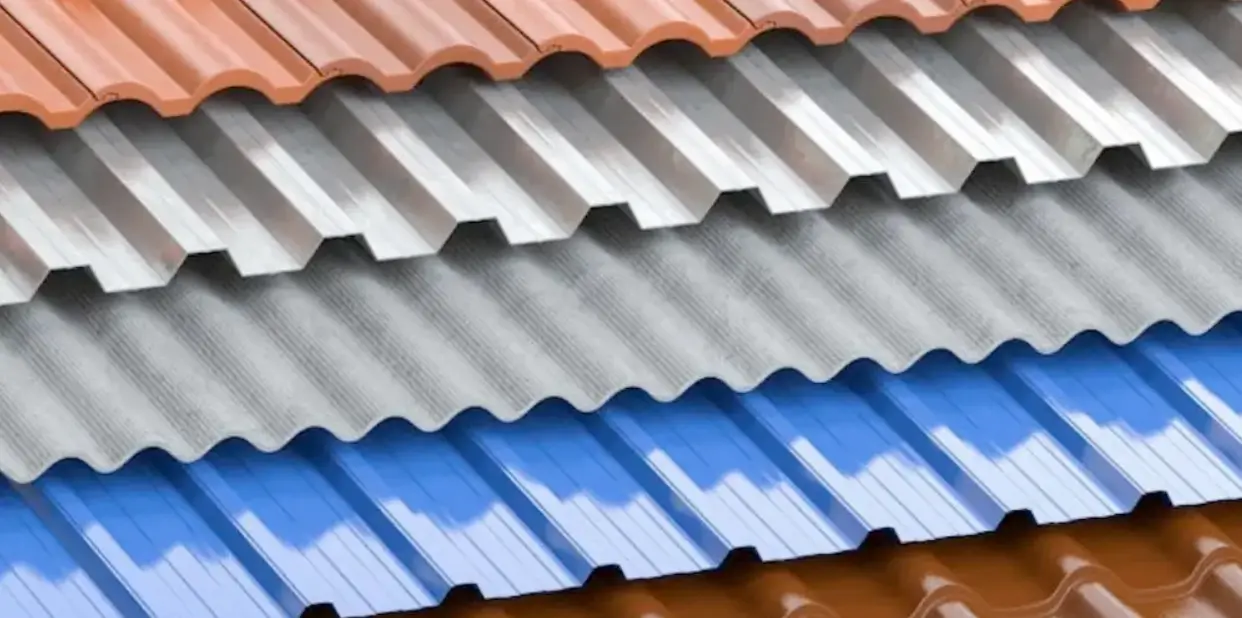 A variety of new corrugated metal roofing materials. As long as the open ridge ends are mitigated to prevent ember intrusion to the roof deck below, corrugated metal can be wildfire resistant.
A variety of new corrugated metal roofing materials. As long as the open ridge ends are mitigated to prevent ember intrusion to the roof deck below, corrugated metal can be wildfire resistant.
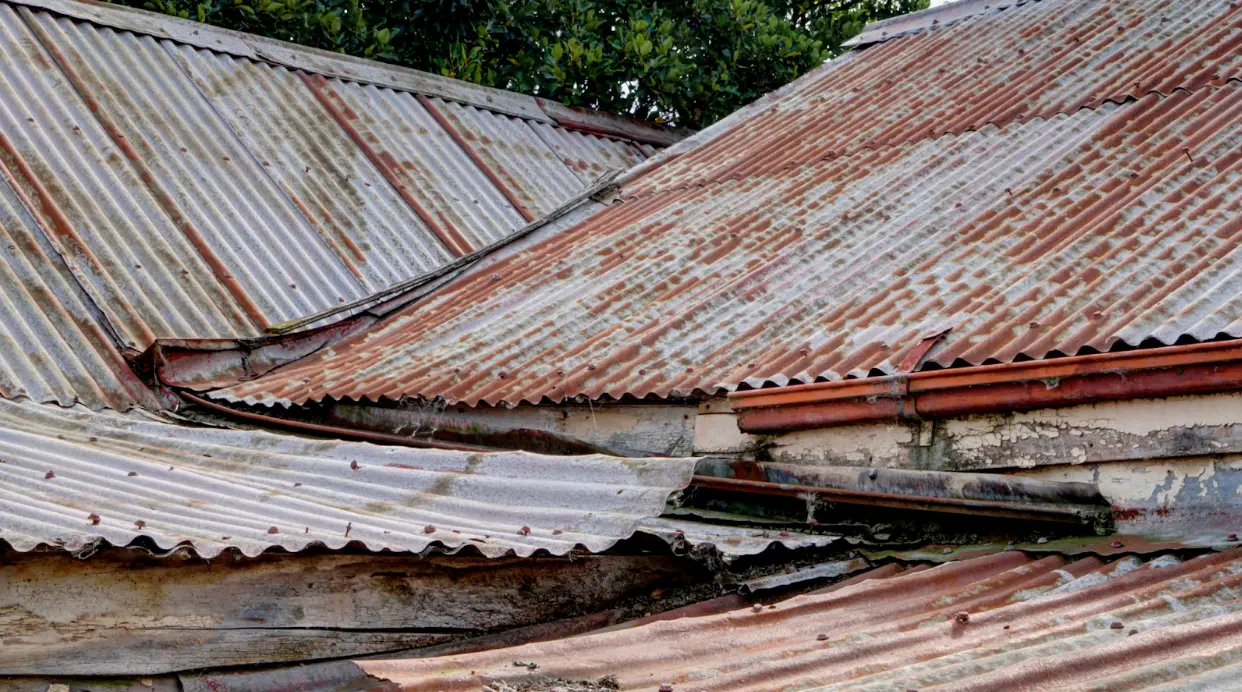 A complex corrugated metal roof with advanced rust and uplift. This roof should be replaced.
A complex corrugated metal roof with advanced rust and uplift. This roof should be replaced.
Tile
Clay barrel and flat masonry style roof tiles are noncombustible themeslves but often installed in a way that can expose the wood roof decking material underneath it to embers during a wildfire (see open ends and ridges).\
Missing or cracked tiles or areas where tiles have moved significantly indicate a degraded roof and must be repaired/replaced in order to be restored to good condition.\
Clay barrel tile roof coverings are common in Southern California.
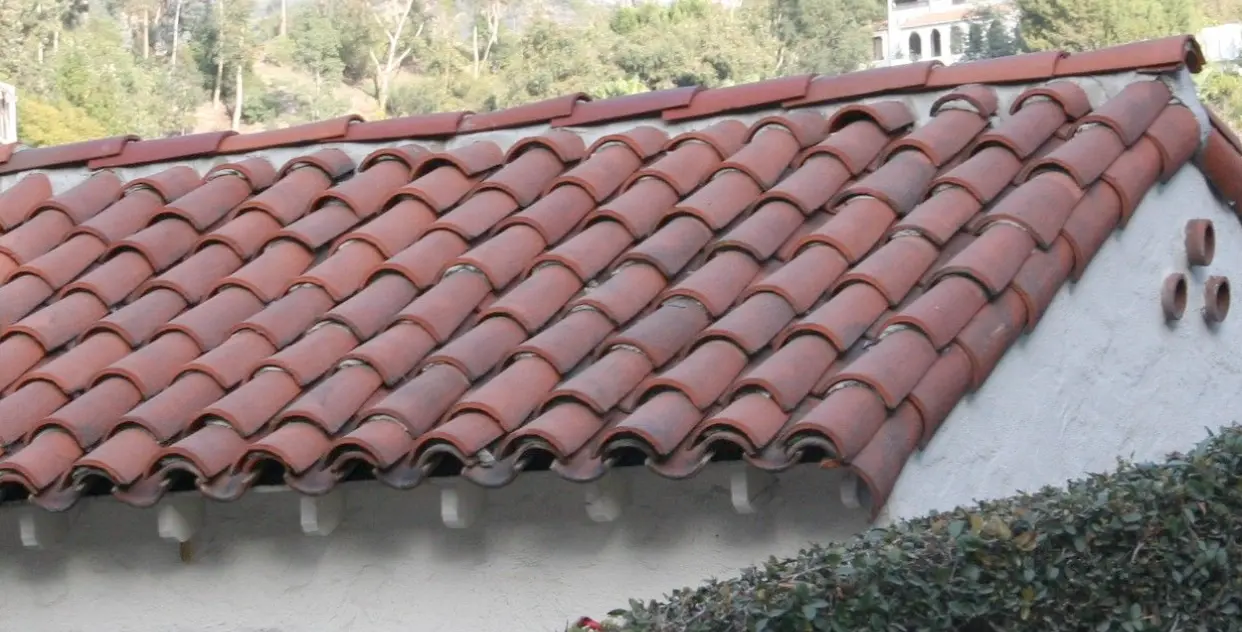 Mission style clay barrel tile roof covering in good condition. Note the presence of mortar along the ridge line of the roof that could replicated in the open ends of the barrel tile to reduce wildfire threats (see open ends and eaves section).
Mission style clay barrel tile roof covering in good condition. Note the presence of mortar along the ridge line of the roof that could replicated in the open ends of the barrel tile to reduce wildfire threats (see open ends and eaves section).
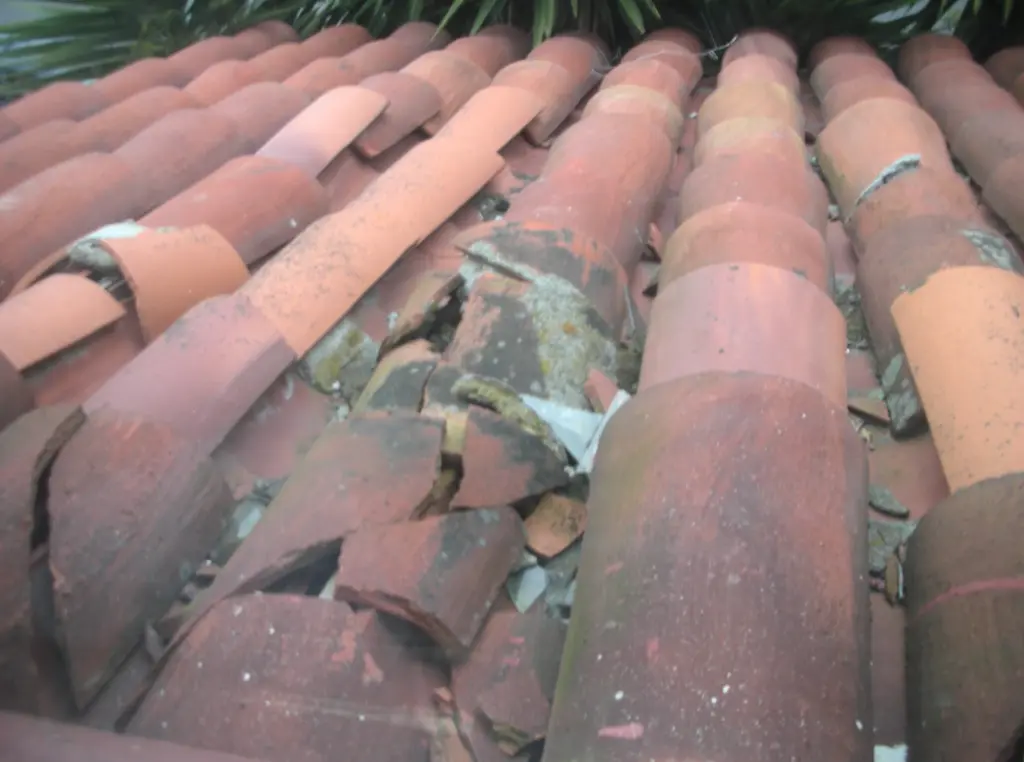 Barrel tile roof with crushed tiles in poor condition. The potential for ember penetration into gaps between the broken tiles means these tiles (or the entire roof) should be replaced.
Barrel tile roof with crushed tiles in poor condition. The potential for ember penetration into gaps between the broken tiles means these tiles (or the entire roof) should be replaced.
 Flat tile. Note opening at ridge cap (at ridge on hip roof) with >1/8" gaps, which creates a debris and ember ignition hazard.
Flat tile. Note opening at ridge cap (at ridge on hip roof) with >1/8" gaps, which creates a debris and ember ignition hazard.
TPO
Thermoplastic polyolefin (TPO) is more common on commercial buildings but can be a good option for any structure with flat or low slope roofs. When assessing the condition of a TPO roof, look for sags or bare areas and delamination around the edges. Brown circles can indicate where water collects and evaporates, suggesting possible infiltration locations into the roof sublayer.
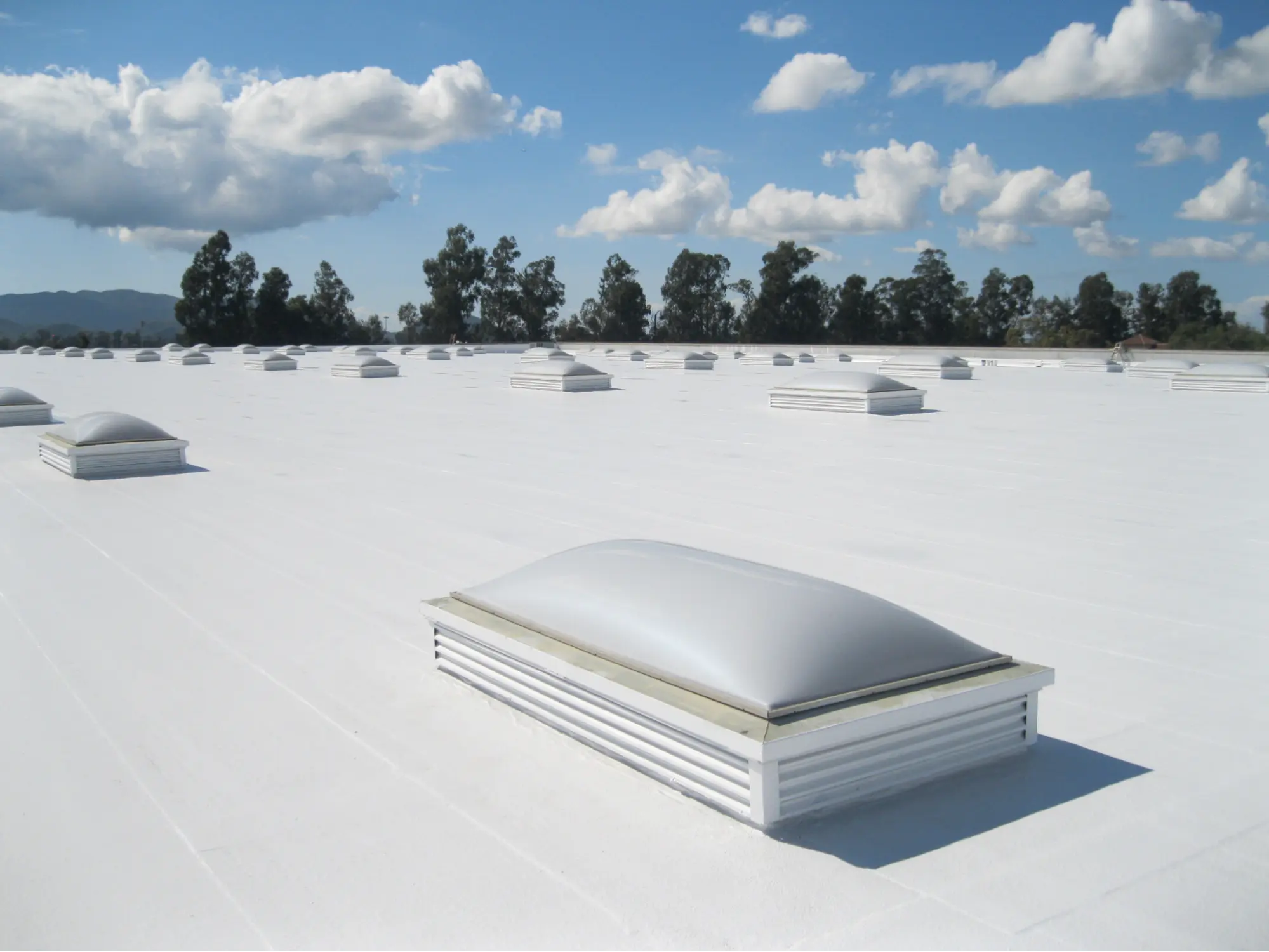 Thermoplastic olefin (e.g., TPO) roof covering in good condition. Source: <a href="https://www.centralhomesroofing.com/wp-content/uploads/2019/07/tpo-roof.jpg">Central Homes Roofing</a>.
Thermoplastic olefin (e.g., TPO) roof covering in good condition. Source: <a href="https://www.centralhomesroofing.com/wp-content/uploads/2019/07/tpo-roof.jpg">Central Homes Roofing</a>.
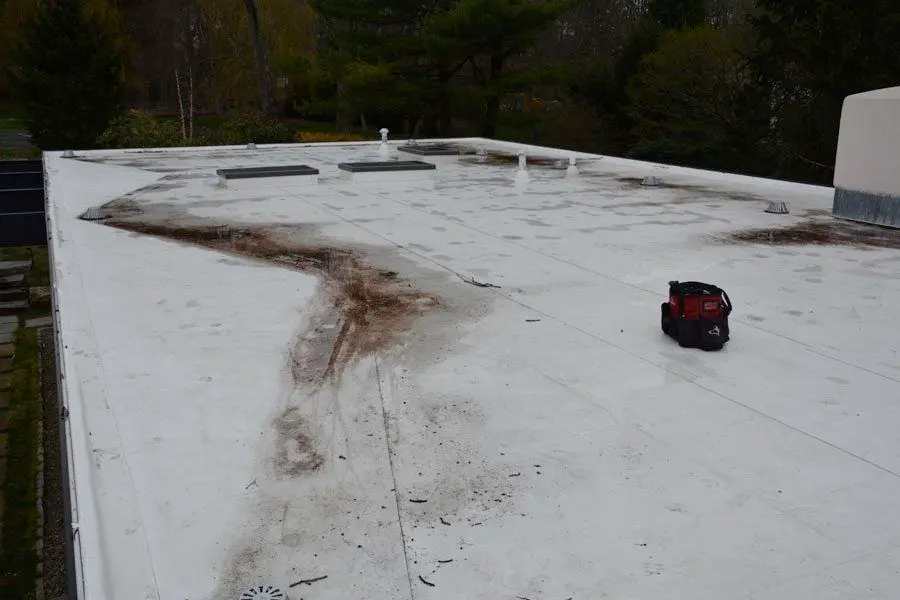 Thermoplastic olefin (e.g., TPO) roof covering in less than good condition with separation along welded seams creating long term water accumulation and drainage issues. This roof should be replaced with a Class A fire-rated option. Source: <a href="https://flatroofdoc.com/tpo-roofing-advantages-disadvantages-commercial-flat-roofs/">Flat Roof Doctor</a>.
Thermoplastic olefin (e.g., TPO) roof covering in less than good condition with separation along welded seams creating long term water accumulation and drainage issues. This roof should be replaced with a Class A fire-rated option. Source: <a href="https://flatroofdoc.com/tpo-roofing-advantages-disadvantages-commercial-flat-roofs/">Flat Roof Doctor</a>.
Modified bitumen
More common on commercial buildings with flat and low slope roofs, this is similar to asphalt composite shingles. The signs of deterioration are sags, bare areas, or loss of granules (similar to asphalt composite shingles).
 Modified bitumen roof covering in good condition. Source: <a href="http://flatroofdoc.com/roofing-materials/">Flatroofdoc.com</a>
Modified bitumen roof covering in good condition. Source: <a href="http://flatroofdoc.com/roofing-materials/">Flatroofdoc.com</a>
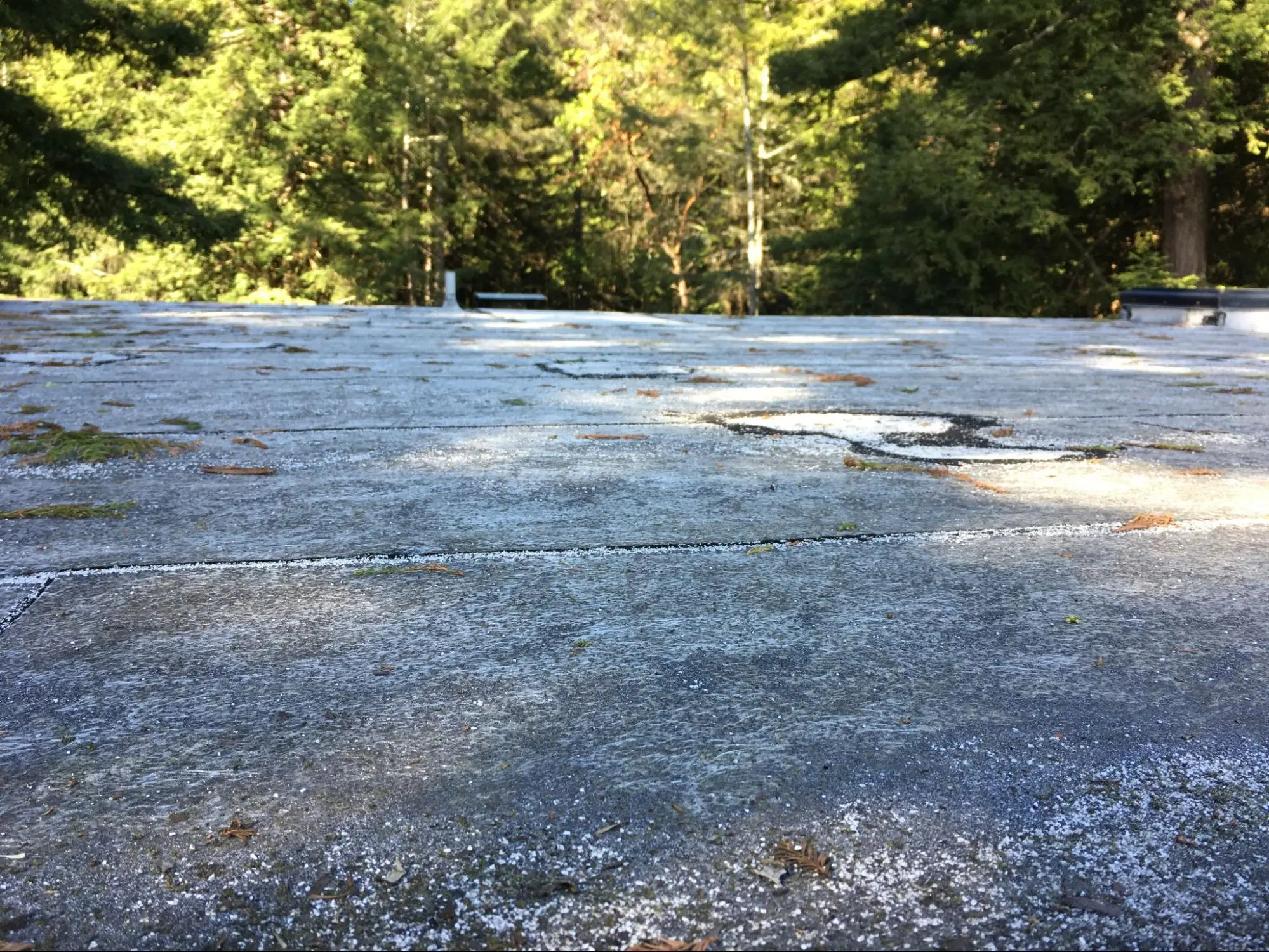 Modified bitumen roof covering with missing granules and sags apparent. This roof is not in good condition and should be replaced.
Modified bitumen roof covering with missing granules and sags apparent. This roof is not in good condition and should be replaced.
Rubber / Plastic
Rubber or plastic roof coverings come in a variety of designs and can be printed to look like asphalt or wood shingles. For this reason, it can be difficult to identify without touching them. One indicator to look more closely is that they tend to be installed on lower cost structures like mobile and manufactured homes where affordability is the primary design criterion.
With no underlayment, rubber or plastic roofs are typically Class C fire-rated, which offer the least amount of resistance to ignition and for this reason, are not recommended. With the addition of an underlayment material that reduces flame penetration of the roof deck, rubber or plastic roof coverings can achieve a Class A by Assembly fire-rating. However, practically, it should not be possible to determine between a Class C and Class A by Assembly because if correctly installed, no underlayment material should be visible.
\
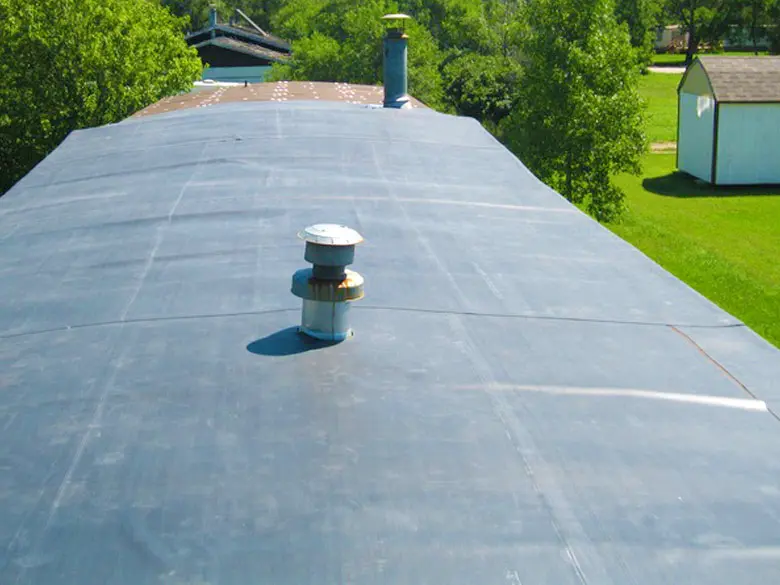 Rubber/plastic roof on a mobile or manufactured home in good condition.
Rubber/plastic roof on a mobile or manufactured home in good condition.
Plastic panel
Plastic panels used as roof coverings are typically transparent, corrugated for strength, and installed on porches and carports where illumination is desired. They’re most commonly made of polyvinyl chloride (PVC) or polycarbonate, which both deform at relatively low temperatures (160-300 deg F).\
During a wildfire, they are susceptible to embers burning through them and deformation from radiant heat, which can deposit ignited debris on whatever is below them. For this reason, they are unable to withstand wildfire exposures and should be replaced with a Class A fire-rated roofing material. Chapter 7A-compliant skylights or light fixtures are the best option to replace the illumination provided by transparent plastic panels.
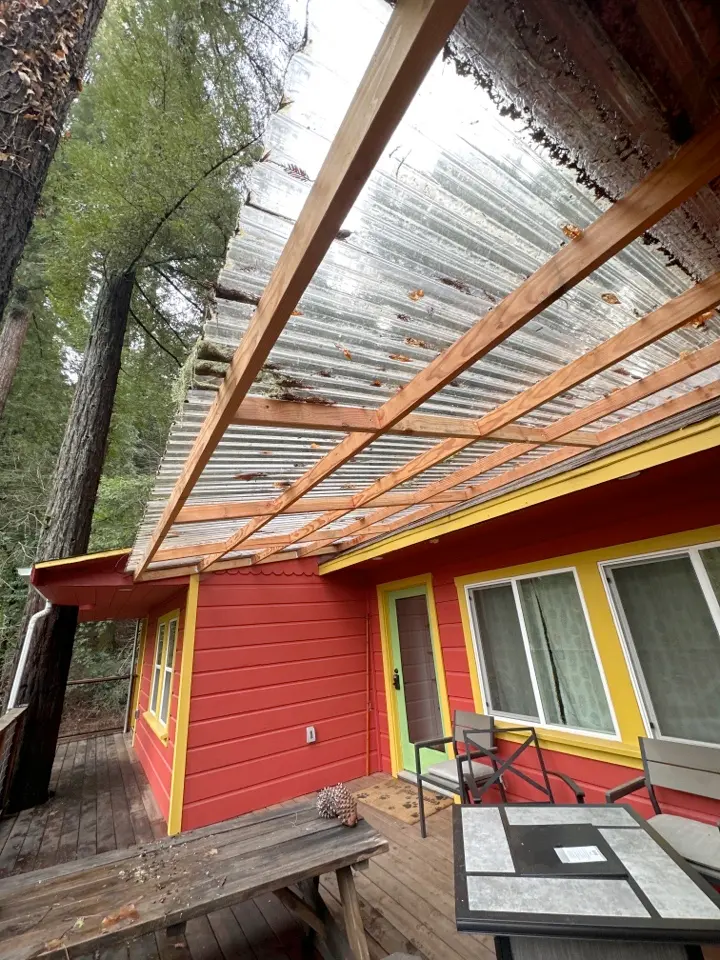 Plastic roof panels in good condition. However, plastic roof panels deform at relatively low heat exposure and should be replaced.
Plastic roof panels in good condition. However, plastic roof panels deform at relatively low heat exposure and should be replaced.
Other
While the most common roof covering materials are described here, there are many ways to build a roof. This category is the catch all for roofs that don’t fit neatly into the other categories described above and must be assessed and mitigated on a case-by-case basis.
Generally, if the roofing material is noncombustible and in good condition, then it is likely not a priority for replacement.
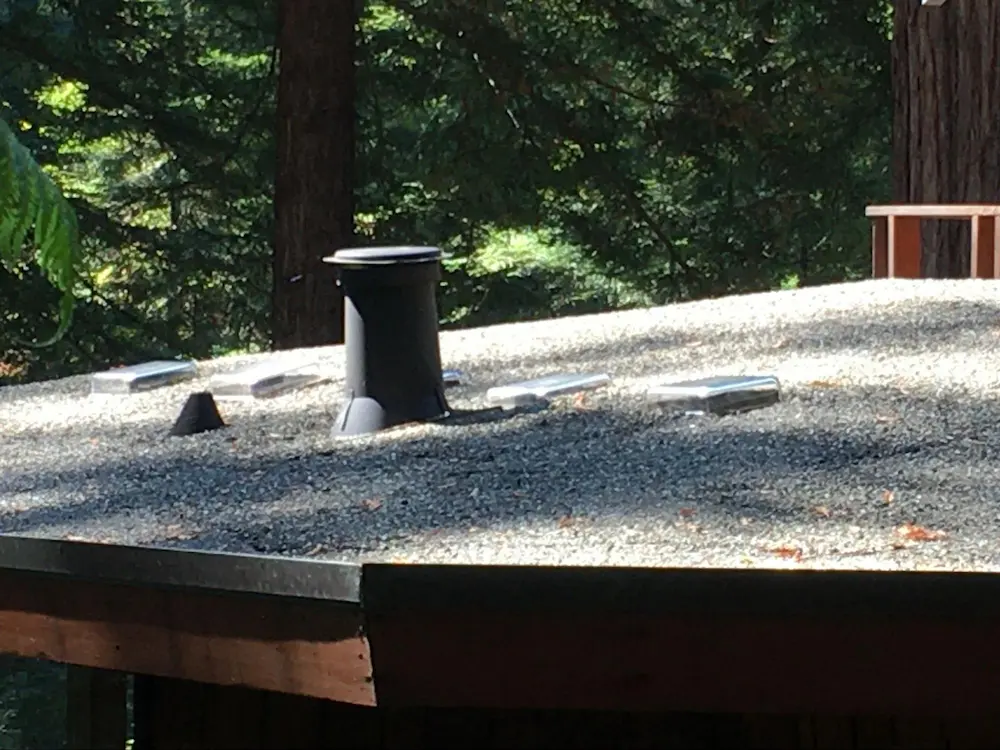 Tar and gravel roof in good condition.
Tar and gravel roof in good condition.
Open ends, hips, and ridges
Some tile and metal roof covering materials have undulating open ends at the eaves or ridges that result in an open gap between the tile and the roof deck (i.e., the roof sheathing). This design presents an opportunity for plant debris and other combustible fine fuels (e.g., bird nesting material, insect nests) to accumulate in this confined area. Wind-blown embers that enter this area can readily ignite these fine fuels and bypass the protection offered by the Class A roof covering.
Clay barrel style tiles may have “bird stops” (end stop or cap) or eave closures designed to prevent critters from accessing underneath the tiles; however, as shown in the figure below, they do not seal the openings sufficiently. In a wind-driven ember wildfire, debris and embers can be blown under the tile roof to the vulnerable roof decking material (e.g., plywood or OSB) through the open ends.
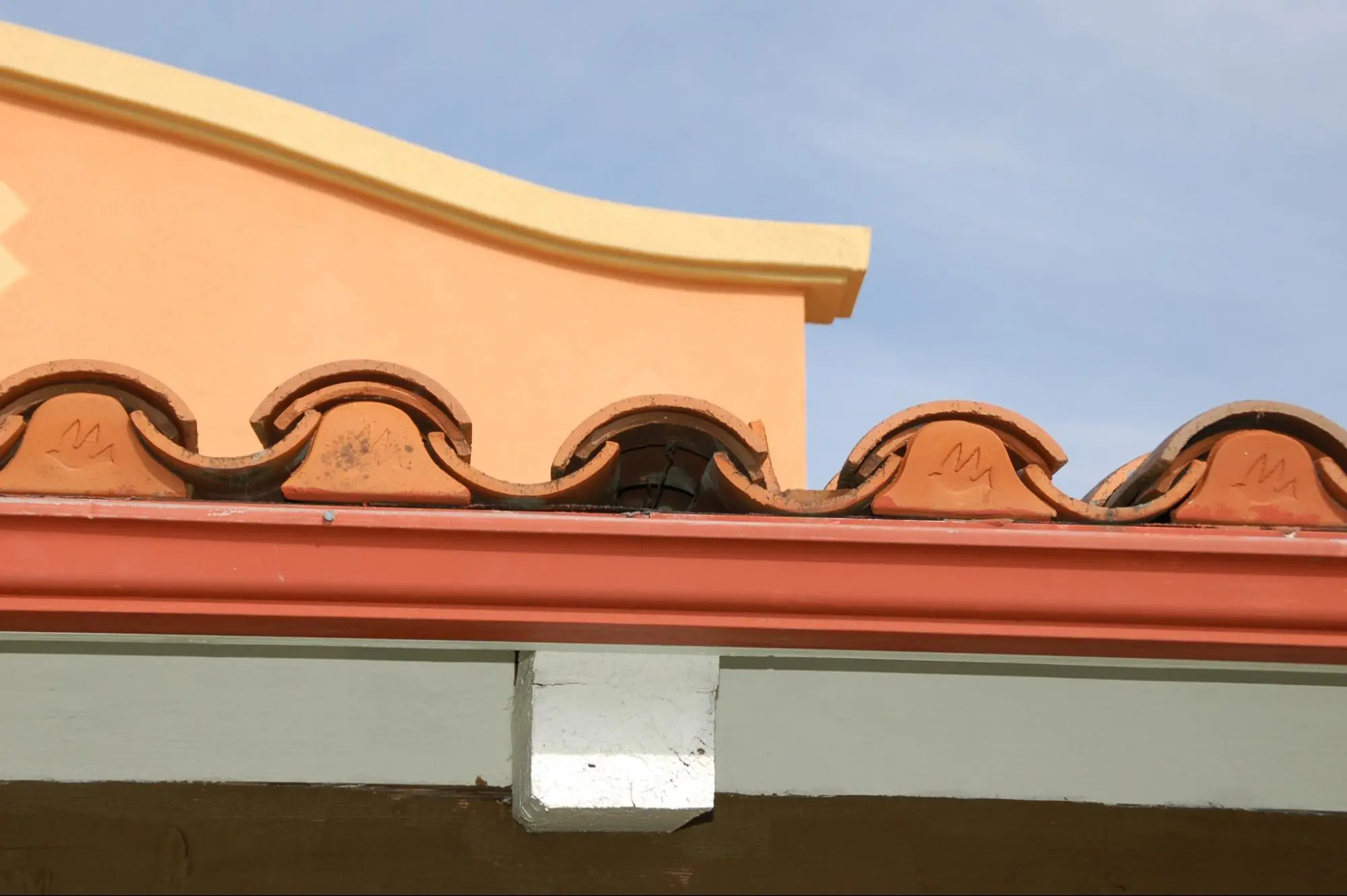 Commercial bird-stop product with one stop missing. Note gaps greater than 1/8" in size between stops and tiles, which creates a debris and ember ignition hazard.
Commercial bird-stop product with one stop missing. Note gaps greater than 1/8" in size between stops and tiles, which creates a debris and ember ignition hazard.
While clay barrel-style tile roofs most commonly suffer from this issue, flat tile, standing seam metal, and corrugated metal roofs can also have open ends or ridges and should be mitigated.
 Flat tile. Note opening at ridge cap (at ridge on hip roof) with >1/8" gaps, which creates a debris and ember ignition hazard.
Flat tile. Note opening at ridge cap (at ridge on hip roof) with >1/8" gaps, which creates a debris and ember ignition hazard.
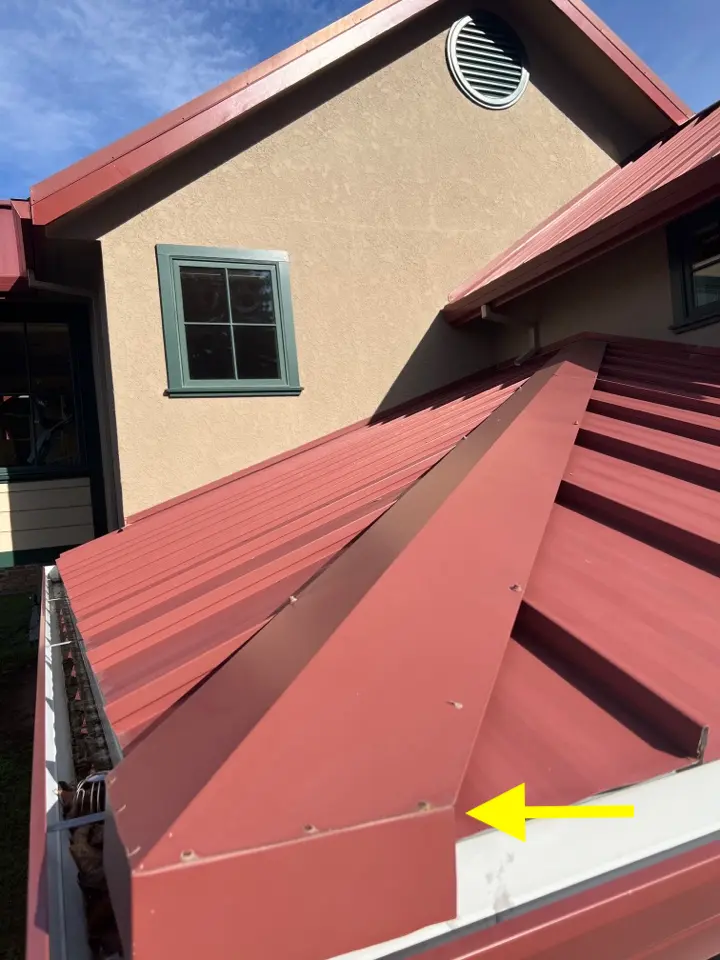 Standing seam metal roof hip rafter covering, which has a 3x2 inch opening at the roof edge (not shown) in which a vacated wasp nest had been built.
Standing seam metal roof hip rafter covering, which has a 3x2 inch opening at the roof edge (not shown) in which a vacated wasp nest had been built.
In some roof applications like covered patios and porches, corrugated metal roof panels are installed on top of heavy timber beams with no roof decking material. This should not be indicated as an open end or ridge because any debris or embers that accumulate on top of the beams are unlikely to ignite heavy timber. Only where there is an opportunity for accumulation on top of low density combustible materials (e.g., plywood, OSB) are open ends or ridges a concern.
To mitigate, there are two options:
- Stuff with a noncombustible material like mineral wool or install 1/8 inch metal mesh screening
- Enclose with mortar
Noncombustible gutter covers are also important to mitigate open ends and the area where hip rafters meet the lower roof edge.
Mineral wool or screen with metal mesh
Noncombustible mineral wool, which resembles raw fluffy wool or cotton, can be stuffed into all roof openings so that no gaps larger than 1/8 inch are present. This can be an affordable option or for those who prefer DIY-friendly solutions.
 Metal roof with open ends and noncombustible mineral wool batt insulation to prevent ember and debris accumulation.
Metal roof with open ends and noncombustible mineral wool batt insulation to prevent ember and debris accumulation.
A more durable option than mineral wool is to install 1/8 inch (or smaller) corrosion-resistant metal mesh so that no gaps larger than 1/8 inch remain between the open roof area and the roof deck material. At this time, friction fitting is recommended to keep the mesh in place to enable maintenance and replacement, if required. Using 1/16 inch mesh may require more maintenance to remove flammable debris accumulation.
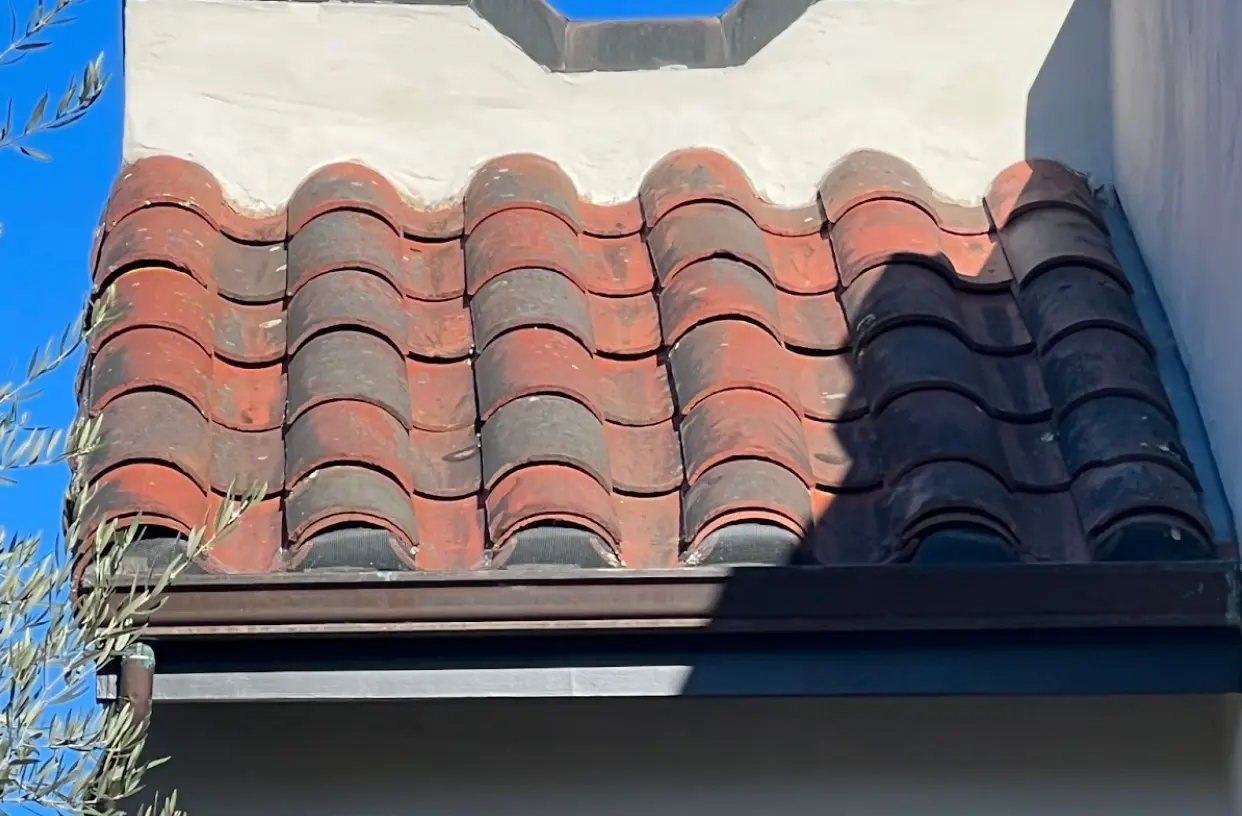 Clay barrel style tile roof with screening installed to mitigate debris and ember risk exposures. This should be paired with an effective noncombustible gutter cover.
Clay barrel style tile roof with screening installed to mitigate debris and ember risk exposures. This should be paired with an effective noncombustible gutter cover.
Enclose with mortar
Mortar is applied in the open area under each barrel tile so that no gaps larger than 1/8 inch are present. This can be challenging due to the number of openings on a clay tile roof and for the need to be diligent, thorough, and precise to avoid mortar application in unwanted areas.
On structures that did not have bird stops installed soon after construction, significant debris has often accumulated that is not feasible to remove, so the only option is to plug the open ends with mortar. Note that even if the eave gaps have been filled, openings at the roof ridges and hips are often overlooked and require special care because the gap is larger than the commercially available bird stops.
Debris accumulation present
Regardless of the type of roof or its condition, it is always important to keep roofs clear of debris like leaves, needles, twigs, and other combustible materials. This is one of the easiest ways to reduce your wildfire risk. Consider removing sources of debris (e.g., large trees) within 30 ft of structures or commit to regularly cleaning your roof.
 Roof with significant accumulation of plant debris, which would be expected to ignite from ember cast during a wildfire.
Roof with significant accumulation of plant debris, which would be expected to ignite from ember cast during a wildfire.
Roof slope
Flat roofs, which for wildfire hardening purposes are defined as less than 3:12 or less (spoken as “three in twelve,” which means 3 feet of rise over 12 feet of run) can be susceptible to debris accumulation, especially around skylights, which poses an ignition risk during a wildfire.
Steeper roofs are generally believed to pose less risk during a wildfire because they resist build up of large amounts of debris that can ignite. However, because they are steeper, they can experience increased exposure to radiant heat from nearby burning structures or vegetation, especially if situated near a steep hillside.
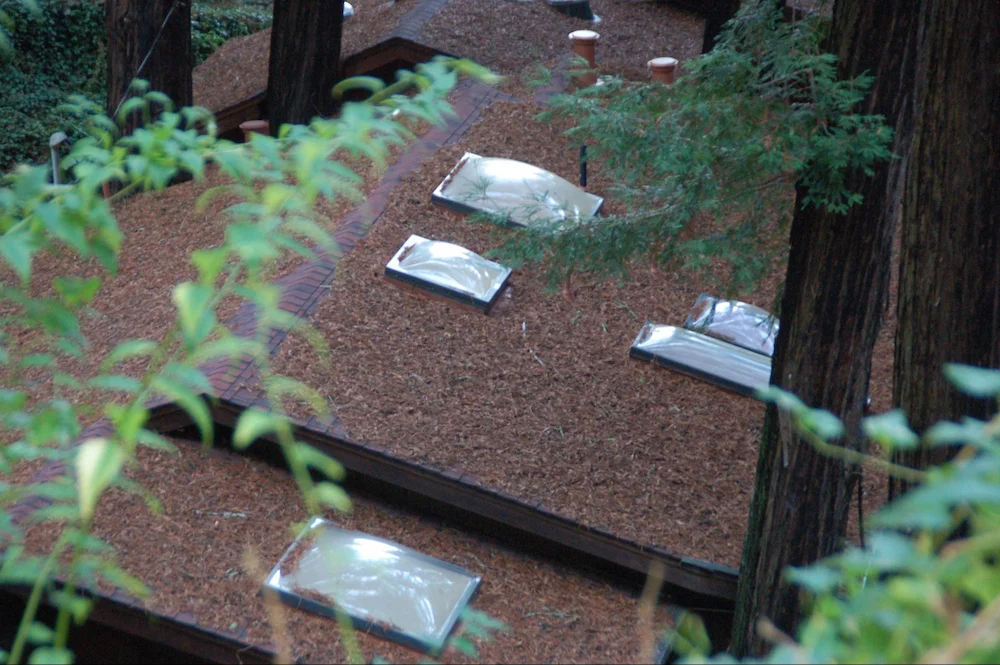 Low slope roof, domed (plastic) skylight. Note accumulation of vegetative debris on the roof and minimal accumulation on the skylight.
Low slope roof, domed (plastic) skylight. Note accumulation of vegetative debris on the roof and minimal accumulation on the skylight.
 Steep slope roof with skylights. Steep slope roofs act more like a wall and generally experience less plant debris accumulation. However, if vegetation or other structures are located in the view-field of the skylight and ignite, they could threaten the roof and skylights with radiant heat exposure.
Steep slope roof with skylights. Steep slope roofs act more like a wall and generally experience less plant debris accumulation. However, if vegetation or other structures are located in the view-field of the skylight and ignite, they could threaten the roof and skylights with radiant heat exposure.